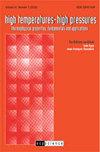用干涉仪测量二氧化钒纳米流体的热光学系数
IF 0.6
4区 工程技术
Q4 Engineering
引用次数: 0
摘要
折射率随温度的变化(dn/dT)定义为热光学系数。它随光的波长和温度而变化,是影响光传播的一个非常重要的物理量。在这项研究中,我们观察了VO2的金属-绝缘体跃迁(MIT)对VO2纳米流体光学性质和纯乙二醇(EG)的热光学系数的影响。我们将50 nm的VO2纳米球分散并注入到1 × 1 × 4 cm3的立方玻璃池中,制备了两种浓度(1 × 10-3 mol%和1 × 10-2 mol%)的EG + VO2纳米流体。热光学系数是用迈克尔逊干涉仪计算干涉条纹运动的次数来测量的。纯EG的热光学系数与文献值在13.3%以内一致。在60℃以下,EG + VO2的热光学系数小于纯EG,但随着温度的升高热光学系数迅速增大。在60℃以上,EG + VO2纳米流体的热光系数迅速变化,分别在62℃和67℃附近出现峰谷。利用热光系数导数的最大值(d2n/dT2)得到了VO2纳米流体的相变温度,在1 × 10-3 mol%和1 × 10-2 mol%的样品中分别为64.6℃和65.0℃。本文章由计算机程序翻译,如有差异,请以英文原文为准。
Measurement of thermo-optic coefficient of vanadium dioxide nanofluids using an interferometer
The change in refractive index with respect to temperature (dn/dT) is defined as the thermo-optic coefficient. It varies according to the light wavelength and temperature, so it is a very important physical quantity that influences light propagation. In this study, we observed the metal-insulator transition (MIT) effect of VO2 on the optical properties of VO2 nanofluid and the thermo-optic coefficient of pure ethylene glycol (EG). We prepared two concentrations (1 × 10–3 mol% and 1 × 10–2 mol%) of EG + VO2 nanofluids by dispersing 50-nm VO2 nano-spheres and injecting them into a cubic glass cell (1 × 1 × 4 cm3). The thermo-optic coefficient was measured by counting the number of interference fringe movements with a Michelson interferometer. The thermo-optic coefficient obtained for pure EG agreed with the literature value within 13.3%. Below 60˚C, the thermo-optic coefficients of EG + VO2 were smaller than that of pure EG, but they increased rapidly as the temperature increased. Above 60˚C, the thermo-optic coefficients of both EG + VO2 nanofluids rapidly changed and showed a peak and valley near 62˚C and 67˚C, respectively. We used the maximum value of the derivative of the thermo-optic coefficient (d2n/dT2) to obtain the phase transition temperatures of the VO2 nanofluids, which were 64.6˚C and 65.0˚C in the samples with 1 × 10–3 mol% and 1 × 10–2 mol%, respectively.
求助全文
通过发布文献求助,成功后即可免费获取论文全文。
去求助
来源期刊

High Temperatures-high Pressures
THERMODYNAMICS-MECHANICS
CiteScore
1.00
自引率
9.10%
发文量
6
期刊介绍:
High Temperatures – High Pressures (HTHP) is an international journal publishing original peer-reviewed papers devoted to experimental and theoretical studies on thermophysical properties of matter, as well as experimental and modelling solutions for applications where control of thermophysical properties is critical, e.g. additive manufacturing. These studies deal with thermodynamic, thermal, and mechanical behaviour of materials, including transport and radiative properties. The journal provides a platform for disseminating knowledge of thermophysical properties, their measurement, their applications, equipment and techniques. HTHP covers the thermophysical properties of gases, liquids, and solids at all temperatures and under all physical conditions, with special emphasis on matter and applications under extreme conditions, e.g. high temperatures and high pressures. Additionally, HTHP publishes authoritative reviews of advances in thermophysics research, critical compilations of existing data, new technology, and industrial applications, plus book reviews.
 求助内容:
求助内容: 应助结果提醒方式:
应助结果提醒方式:


